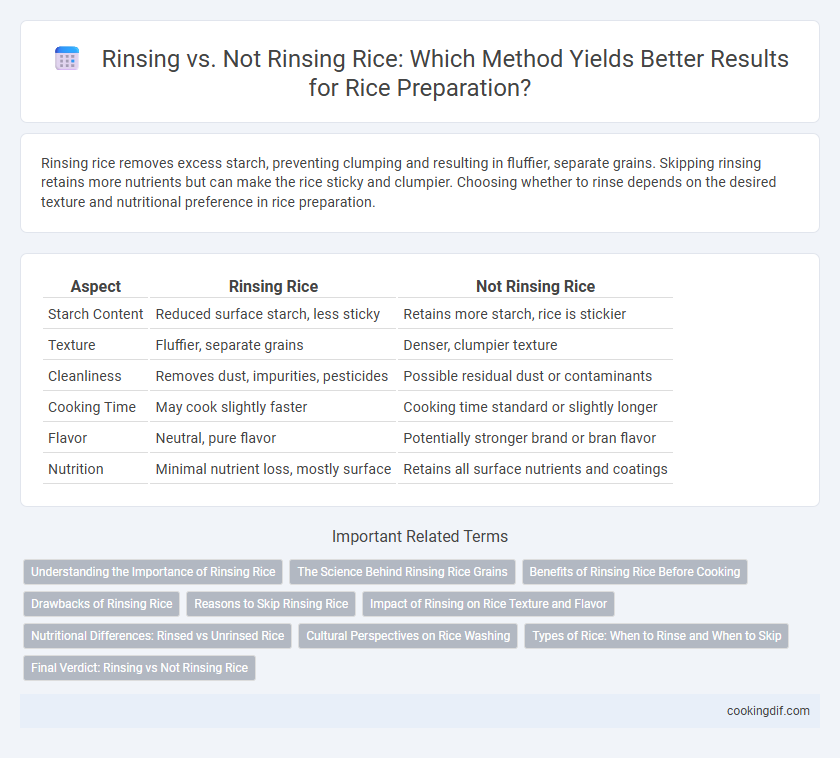Rinsing rice removes excess starch, preventing clumping and resulting in fluffier, separate grains. Skipping rinsing retains more nutrients but can make the rice sticky and clumpier. Choosing whether to rinse depends on the desired texture and nutritional preference in rice preparation.
Table of Comparison
| Aspect | Rinsing Rice | Not Rinsing Rice |
|---|---|---|
| Starch Content | Reduced surface starch, less sticky | Retains more starch, rice is stickier |
| Texture | Fluffier, separate grains | Denser, clumpier texture |
| Cleanliness | Removes dust, impurities, pesticides | Possible residual dust or contaminants |
| Cooking Time | May cook slightly faster | Cooking time standard or slightly longer |
| Flavor | Neutral, pure flavor | Potentially stronger brand or bran flavor |
| Nutrition | Minimal nutrient loss, mostly surface | Retains all surface nutrients and coatings |
Understanding the Importance of Rinsing Rice
Rinsing rice removes excess surface starch that causes clumping and ensures fluffy, separate grains after cooking. It also eliminates impurities and potential pesticide residues, improving both texture and safety. Skipping this step can result in sticky or unevenly cooked rice, affecting overall dish quality.
The Science Behind Rinsing Rice Grains
Rinsing rice grains removes surface starch, preventing clumping and resulting in fluffier, separate grains after cooking. Studies show that unwashed rice retains more starch, which can cause a stickier texture preferred in some dishes but undesirable in others like pilaf or biryani. Microscopic analysis reveals that rinsing also eliminates dust, debris, and potential contaminants, enhancing the rice's purity and overall taste quality.
Benefits of Rinsing Rice Before Cooking
Rinsing rice before cooking removes surface starch, preventing grains from becoming sticky and clumping together, resulting in a fluffier texture. It also eliminates dust, dirt, and potential pesticide residues, enhancing the rice's cleanliness and safety. Furthermore, rinsing can improve the rice's flavor by washing away residual bran particles.
Drawbacks of Rinsing Rice
Rinsing rice removes surface starch that can help achieve a creamier texture in certain dishes like risotto or paella, potentially resulting in a less desirable consistency. Excessive rinsing may also wash away water-soluble nutrients such as B vitamins and minerals, reducing the rice's nutritional value. Furthermore, rinsing rice before cooking can waste time and water, impacting both kitchen efficiency and environmental sustainability.
Reasons to Skip Rinsing Rice
Skipping rinsing rice preserves its natural nutrients and water-soluble vitamins, enhancing the nutritional value. Unrinsed rice retains surface starch, resulting in a stickier texture preferred in dishes like sushi or risotto. Rinsing may also wash away essential minerals and flavor compounds, affecting the overall taste and quality of the cooked rice.
Impact of Rinsing on Rice Texture and Flavor
Rinsing rice removes surface starch that can cause grains to clump together, resulting in a lighter, fluffier texture. It also helps eliminate any residual bran or impurities that may impart a bitter or off-flavor, enhancing the natural taste of the rice. However, some varieties like sushi rice benefit from minimal rinsing to retain a slightly sticky texture essential for proper preparation.
Nutritional Differences: Rinsed vs Unrinsed Rice
Rinsing rice removes surface starch and some water-soluble nutrients such as vitamin B and minerals, slightly reducing its nutritional content. Unrinsed rice retains more of these nutrients but may result in a stickier texture due to the retained starch. Choosing between rinsed and unrinsed rice depends on preference for texture versus maximizing micronutrient retention.
Cultural Perspectives on Rice Washing
Cultural practices surrounding rice rinsing vary significantly across regions, reflecting diverse culinary traditions and rice varieties. In East Asian countries like Japan and Korea, rinsing rice multiple times removes surface starch, resulting in a less sticky texture favored in sushi and traditional dishes. Conversely, some South Asian and Middle Eastern cuisines often skip rinsing to retain starch for creamier, more cohesive rice preparations like biryani or pilaf.
Types of Rice: When to Rinse and When to Skip
Long-grain white rice and basmati benefit from rinsing to remove excess surface starch, preventing clumping and ensuring fluffier results. Short-grain and sushi rice typically require rinsing multiple times to achieve the desired sticky texture by eliminating surface starch and impurities. Parboiled and some enriched rices often do not need rinsing, as washing can strip away nutrients and alter their cooking quality.
Final Verdict: Rinsing vs Not Rinsing Rice
Rinsing rice removes surface starch and impurities, resulting in fluffier, less sticky grains ideal for dishes like pilafs or fried rice. Not rinsing preserves more nutrients and enhances natural flavor but may produce clumpier, stickier rice suited for sushi or risotto. The final choice depends on the desired texture and culinary application, with rinsing favored for clarity and separation, while skipping rinsing works well for creamier, stickier rice dishes.
Rinsing vs Not rinsing for rice preparation Infographic

 cookingdif.com
cookingdif.com